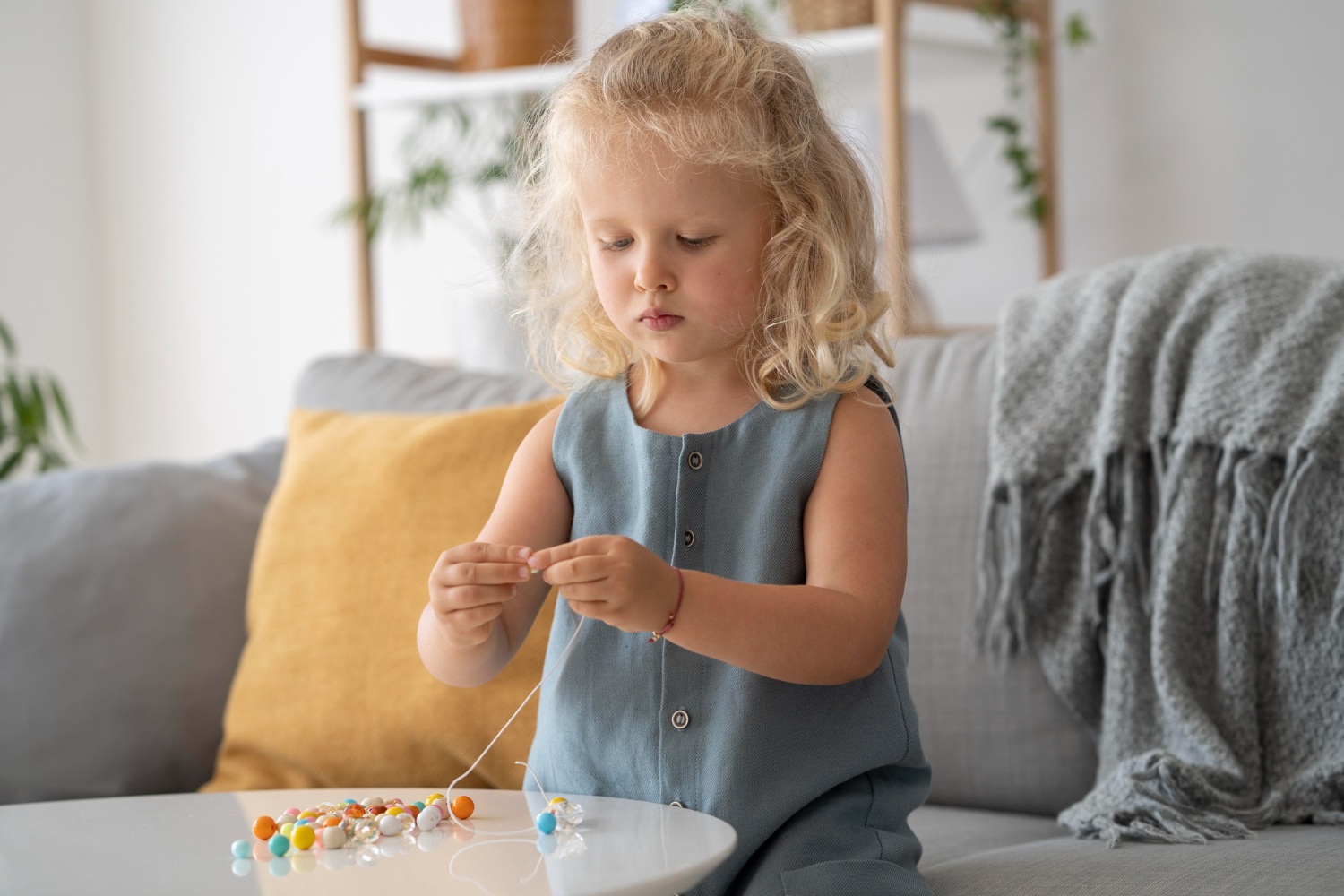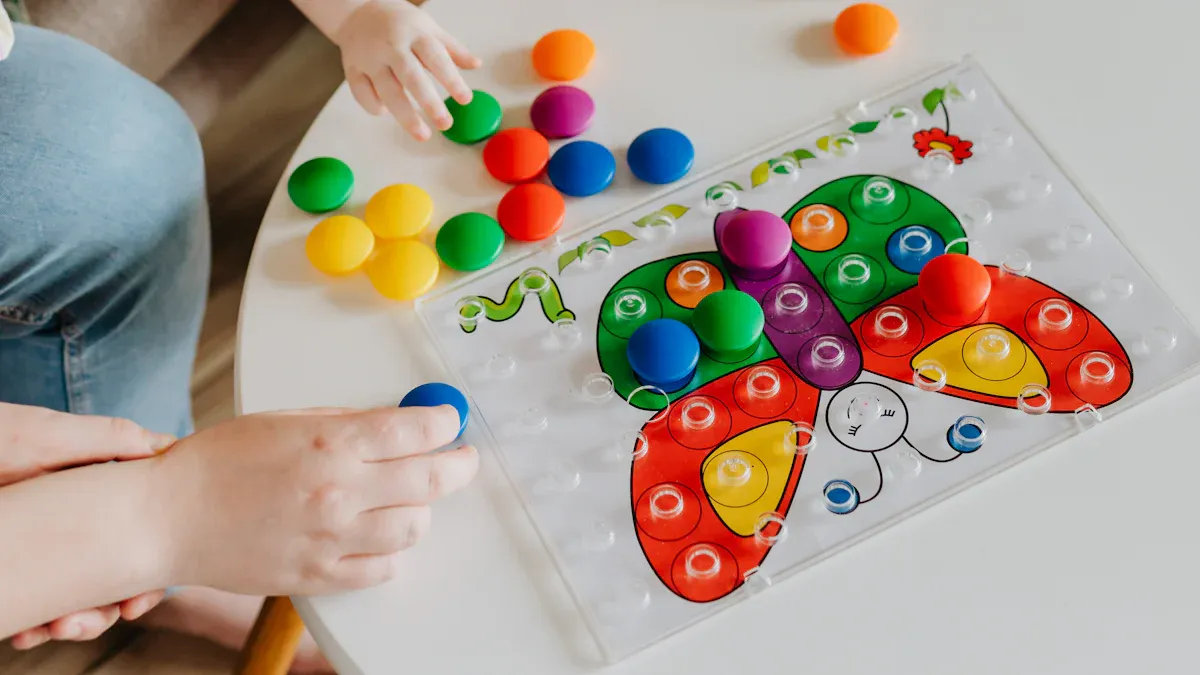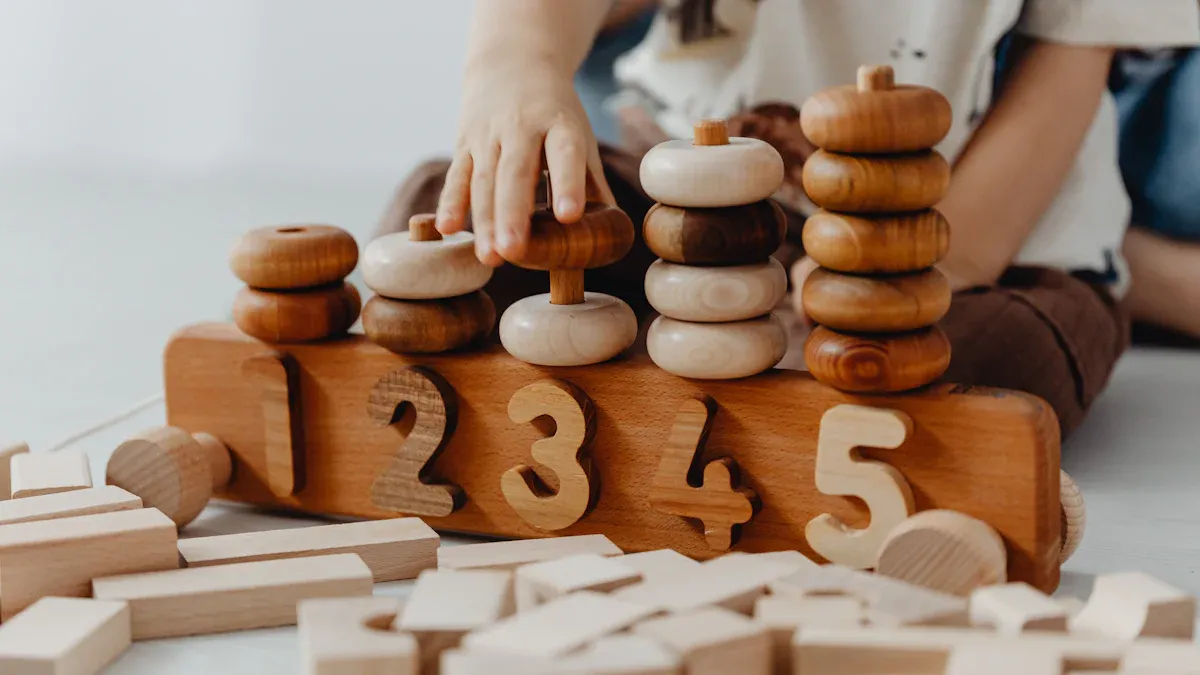Recommended Fine Motor Skills Toys by Age Group

Fine motor skills are very important in your child’s life. They help with things like holding a spoon or tying shoes. Studies show that 10% to 24% of preschool kids have trouble with fine motor skills. To support your child's development, consider incorporating fine motor skills toys into their playtime.
You want to help your child, but choosing the right fine motor skills toys can be hard.
Concern | Description |
|---|---|
Safety | Pick fine motor skills toys that are safe and strong. Make sure they do not have dangerous chemicals. |
Developmental appropriateness | Choose fine motor skills toys that fit your child’s age and what they like. |
Educational value | Find fine motor skills toys that help your child learn and be creative. |
Longevity | Get fine motor skills toys that your child can use for a long time. Or pick toys that give new challenges as they grow. |
Interactivity | Choose fine motor skills toys that help your child play with others and build social skills. |
When you pick fine motor skills toys that fit your child’s stage, you help them get better at hand-eye coordination. You also help them solve problems and feel more confident.
Key Takeaways
Fine motor skills help with daily tasks like buttoning shirts and using pencils. They make kids feel confident and help them do well in school.
Picking toys for fine motor skills helps hand-eye coordination and problem-solving. Choose toys that your child likes and enjoys.
Playtime is important for building fine motor skills. Doing things like stacking blocks and threading beads makes learning fun.
Safety and strength matter when picking toys. Make sure toys are strong and fit your child's way of playing to keep them safe.
Add fine motor skill activities to daily life. Easy things like drawing or buttoning clothes can really help your child get better at these skills.
Why Fine Motor Skills Matter
Benefits for Children
Fine motor skills are important for your child every day. These skills help with things like buttoning shirts or using pencils. They also help your child open lunchboxes and do other small tasks. Practicing fine motor skills helps your child do better at school and at home. Kids with strong fine motor skills do well in reading and math. They also do better in writing and drawing because of good hand-eye coordination.
Here are some ways fine motor skills help your child:
Your child feels more confident and can do things alone, like dressing and eating.
Better writing and creative skills help your child do well in school.
Good fine motor skills help your child make friends and play together.
Early practice gets your child ready for school and group work.
Fine motor skills help your child do well in class and get along with others.
When you use fine motor skills toys and activities, you help your child learn and make friends.
Role of Play
Playing is a great way for your child to build fine motor skills. When your child uses fine motor skills toys, they move their fingers, hands, and eyes together. This helps them learn to control small movements and solve problems.
Here’s how different play activities help:
Activity | Benefit |
|---|---|
Stacking blocks | |
Threading beads | Makes grip stronger and fingers more skilled |
Manipulating small objects | Builds motor control and independence |
You can also try sensory play, crafts, drawing, and games. These activities make learning fun and help your child feel proud. Picking fine motor skills toys that fit your child’s age helps them grow and enjoy playtime.
Fine Motor Skills Toys for Infants

Top Toy Types
When you pick fine motor skills toys for infants, choose safe and easy ones. Babies like toys that make noise, move, or have bright colors. These things catch their eye and make them want to play. Some of the best fine motor skills toys for infants are:
Interlocking blocks
Colorful rattles
Whimsical manipulatives
Activity sets
Age-appropriate loose parts
Stacking toys
Lacing activities
You can also use baby blocks, rolling toys, and rattles for wrists or ankles. These toys help babies grab and shake things. Babies like beads and objects they can hold and move around. You might see your baby trying to stack or connect pieces. These activities help your baby use their fingers better and make playtime fun.
Tip: Pick toys with different feels and bold colors. These help your baby's senses and keep them interested.
Here’s a quick look at how toys for infants are not the same as toys for older kids:
Age Group | Design Characteristics | Functionality |
|---|---|---|
Infants | Simple and safe toys focus on grasping and sensory play. Rattles, stacking rings, and soft toys are good examples. | These toys help babies get stronger hands and fingers while they feel new textures. |
Older Children | Toys are harder, like shape sorters and building blocks. These need more skill and thinking. | These toys help kids build advanced fine motor skills. |
Developmental Support
Fine motor skills toys for infants do more than just keep babies busy. They help babies learn to grab, reach, and move things. When your baby shakes a rattle or stacks blocks, they get better at using their hands and eyes together. Toys with bumpy surfaces and bright colors wake up your baby's senses. This helps your baby's brain grow and supports fine motor skills.
You might see your baby crawl after a toy that rolls. Crawling is good for your baby's brain and movement skills. As your baby crawls, they learn about their world and get better at moving. These actions help your baby get ready for learning and being independent later.
The best fine motor skills toys for infants help babies use their hands, fingers, and eyes together. You help your baby feel sure of themselves and get ready for new things as they grow.
Fine Motor Skills Toys for Toddlers
Best Toy Picks
Toddlers like to touch and try new things. You want toys that keep their hands busy. The best fine motor skills toys let them play and learn in many ways. Here are some top picks that experts suggest:
Busy boards with zippers, buttons, and locks
Lock puzzles
Stacking toys and linking chains
Activity mats with textures and flaps
Push-pull toys
Lacing beads and lacing cards
Pop tubes and tactile sensory balls
Pegboards and tweezers
These fine motor skills toys help your child get stronger. They also help with focus and moving hands better. You can also use Legos, pop cubes, and bean bags for more fun.
Tip: Pick toys with bright colors and different feels. These keep your child interested and help their senses grow.
Skill Building
Fine motor skills toys do more than just keep toddlers busy. They help your child grab, pinch, and move things on purpose. Magnetic fishing games make your child use both hands together. This helps with hand-eye coordination and using both sides of the body. Busy boards and lock puzzles let your child twist and slide pieces. This makes their fingers stronger and helps them solve problems.
Skill Type | How Toys Help Toddlers |
|---|---|
Fine Motor Skills | Picking up small pieces or using beads strengthens finger control. |
Bilateral Coordination | Using both hands with fishing games or stacking toys boosts coordination. |
Hand-Eye Coordination | Matching, sorting, and stacking pieces sharpens visual and motor skills. |
Cognitive Skills | Sorting, counting, and matching activities support thinking and learning. |
Stacking toys and linking chains teach your child to grab and let go. This is important for fine motor growth. These toys also help with balance as your child sits and stacks. Playing together helps your child learn new words and talk with others. Fine motor skills toys help children feel brave and try new things by themselves.
Fine Motor Skills Toys for Preschoolers

Recommended Options
When you look for fine motor skills toys for preschoolers, you want choices that spark curiosity and keep little hands busy. You can find many options that help children get ready for school tasks. Here are some of the best fine motor skills toys for this age group:
Jumbo Test Tubes with Stand Set: Kids love using droppers and tweezers, which boost dexterity.
Animal Lacing Cards: Threading beads through these cards helps with eye-hand coordination.
Wikki Stix: These bendable sticks encourage creativity and fine motor development.
Play-Doh Bakery Creations Set: Squeezing, rolling, and shaping dough strengthens hand muscles.
KID K’NEX – Budding Builders Building Set: Building sets challenge children to solve problems and use their fingers in new ways.
LEGO Classic Large Creative Brick Box: Open-ended play with bricks gives endless chances for fine motor skills practice.
Activity tables and ball poppers also make great additions to your playroom. You can set up a table with puzzles, beads, and building sets to keep your child engaged.
Tip: Choose toys that let your child pinch, squeeze, and twist. These actions help build strong hands for writing and cutting.
Enhancing Fine Motor Skills
You might wonder how these toys help your child get ready for school. Activity tables and ball poppers do more than entertain. They help children build strength and coordination, which are key for writing and cutting. Take a look at this table:
Skill Necessary for Handwriting | Activities for Fine Motor Strengthening |
|---|---|
Strength | Ball poppers |
Ball poppers help children develop fine motor strength and coordination. These skills make it easier for your child to hold pencils and use scissors.
Complex puzzles also play a big role in fine motor development. Studies show that preschoolers who play with puzzles and do brain exercises improve their motor skills. Most children who try these activities show better control and standard motor skills after just a short time.
When you offer fine motor skills toys like puzzles, beads, and building sets, you help your child get ready for school tasks. These toys make learning fun and support healthy development.
Fine Motor Skills Toys for Early Elementary
Top Choices
Kids in early elementary school need to keep making their hands and fingers strong. They like toys that are fun and make them think. Teachers say these toys are great for fine motor skills:
Building sets like magnetic tiles and LEGO kits
Craft kits with beads, string, and scissors
Advanced puzzles with small pieces
Model kits that require assembly
Sewing or weaving sets
Clay and sculpting tools
These fine motor skills toys help your child use both hands together. Your child squeezes, pinches, and moves things carefully. These toys also help with shoulder strength and finger control. Playing with these toys makes writing and drawing easier. Your child gets better at doing small tasks.
Tip: Mix up the toys you give your child. Some days they might want building sets. Other days, they may pick craft kits. This keeps playtime new and fun.
Ongoing Development
Fine motor skills toys do more than just keep kids busy. They help your child feel more sure of themselves. When your child builds or crafts, they use their hands and eyes together. This helps them grab things and control their movements. Playing with others teaches teamwork and problem-solving.
Building sets and craft kits let kids use their hands.
These toys help your child think and learn by playing.
Craft stick projects teach squeezing and stacking.
Your child learns to be creative and work with friends.
Teachers and therapists use different ways to see how kids are doing. Here is a table that shows how they check progress:
Assessment Method | Description |
|---|---|
Standardized Assessments | Checklists show how your child is growing |
Observational Methods | Adults watch your child play and do daily things |
Work Samples | Art or videos help track your child’s skills |
Collaboration | Parents and teachers share ideas about your child’s abilities |
Choosing good toys and watching your child play helps them get better at fine motor skills and become more independent.
Tips for Choosing Fine Motor Skills Toys
What to Look For
When you shop for fine motor skills toys, you want to make sure they are safe, fun, and right for your child’s age. Safety always comes first. Look for toys that are sturdy and made from quality materials. Avoid cheap toys from discount stores, since they might not be safe for mouthing or rough play. If your child likes to throw toys, lightweight plastic blocks are a better choice than heavy wooden ones.
Here’s a quick table to help you remember what matters most:
Criteria | Description |
|---|---|
Pick toys that are well-made and can handle lots of use. | |
Avoid Cheap Materials | Stay away from toys that might break or have unsafe parts. |
Consider Child's Behavior | Choose toys that fit how your child likes to play. |
You also want toys that keep your child interested and help with development. Great toys encourage creativity, problem-solving, and hand-eye coordination. An open-ended toy, like wooden pattern blocks and boards, lets your child build and explore in many ways. Colorful wooden beads are another good pick because they make lacing and stacking more exciting.
Tip: Always check for small parts, sharp edges, or anything that could be a choking hazard.
Playtime Tips
You can make playtime a special part of your daily routine. Try setting aside 10-15 minutes, three to five times a week, for focused play. Simple activities like threading colorful wooden beads, stacking blocks, or drawing with chalk help build fine motor skills. Everyday tasks, such as buttoning shirts or spreading jam, also support skill development.
Sensory play is a great way to keep children engaged. You can even make your own toys at home, which saves money and lets your child help with the process. Encourage your child to use utensils at meals, sort laundry, or tie shoes. These small moments add up and make a big difference.
Remember: The best fine motor skills toys are the ones your child loves and wants to use again and again!
You can help your child learn by picking fine motor skills toys that fit their age and skills. Toy choices change as your child grows older. For example, infants need sensory and grasping toys. Toddlers do best with stacking toys and puzzles. Preschoolers like building sets and craft activities. Kids in elementary school enjoy advanced kits and art projects.
Watch your child play and see what they like most. Choosing toys that match their interests makes playtime special. Studies show that playing with goals and planned activities helps motor skills. These skills can even help your child do better in school later. When you use play to build fine motor skills, you help your child learn for life and feel confident.
FAQ
What are fine motor skills toys?
Fine motor skills toys help your child use small muscles in their hands and fingers. These toys include blocks, puzzles, beads, and craft kits. You can use them to help your child get better at gripping, pinching, and moving objects.
How often should my child play with fine motor skills toys?
Try to let your child play with these toys every day. Even 10-15 minutes helps. You can mix playtime with daily tasks, like buttoning shirts or drawing. The more practice, the better!
Are fine motor skills toys safe for all ages?
Most fine motor skills toys are safe if you pick the right ones for your child’s age. Always check for small parts, sharp edges, or loose pieces. If you have a baby or toddler, choose larger toys that cannot fit in their mouth.
Can I make fine motor skills toys at home?
Yes! You can use things like pasta, clothespins, or buttons for fun activities. Homemade toys work well and save money. Just make sure everything is clean and safe for your child to handle.
What signs show my child needs more fine motor practice?
Look for these signs:
Trouble holding crayons or scissors
Difficulty buttoning clothes
Avoiding puzzles or crafts
If you notice these, add more fine motor play to your child’s routine.
See Also
Comprehensive Evaluations of Top Motor Skills Toys for Kids
Top Sensory Toys for Toddlers Based on Their Age
An Extensive Overview of Montessori Toys for Motor Skills
Evaluating Sensory Toys for Children with Unique Requirements
The Role of Sensory Toys in Enhancing Motor Skills for Autistic Children
